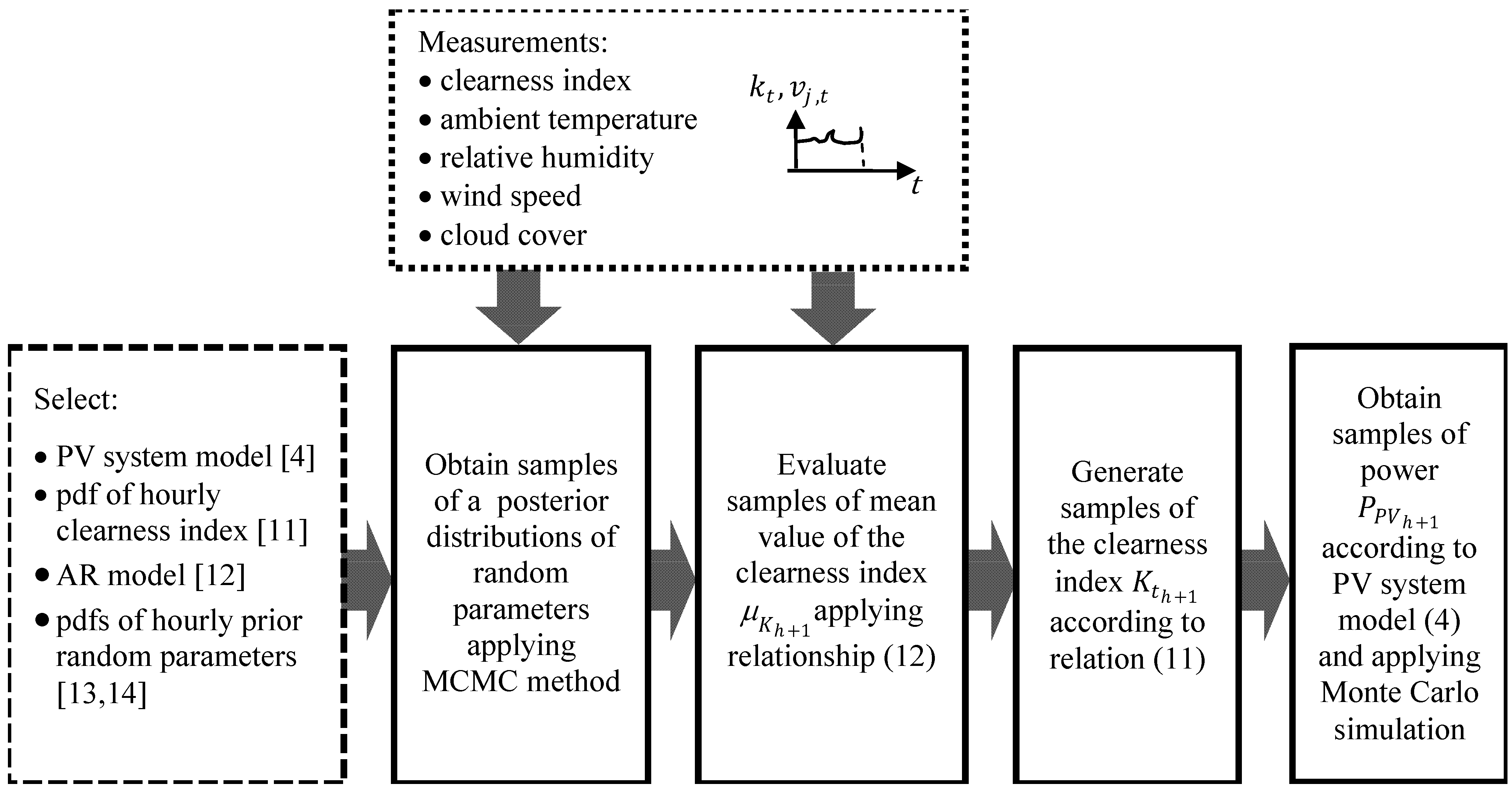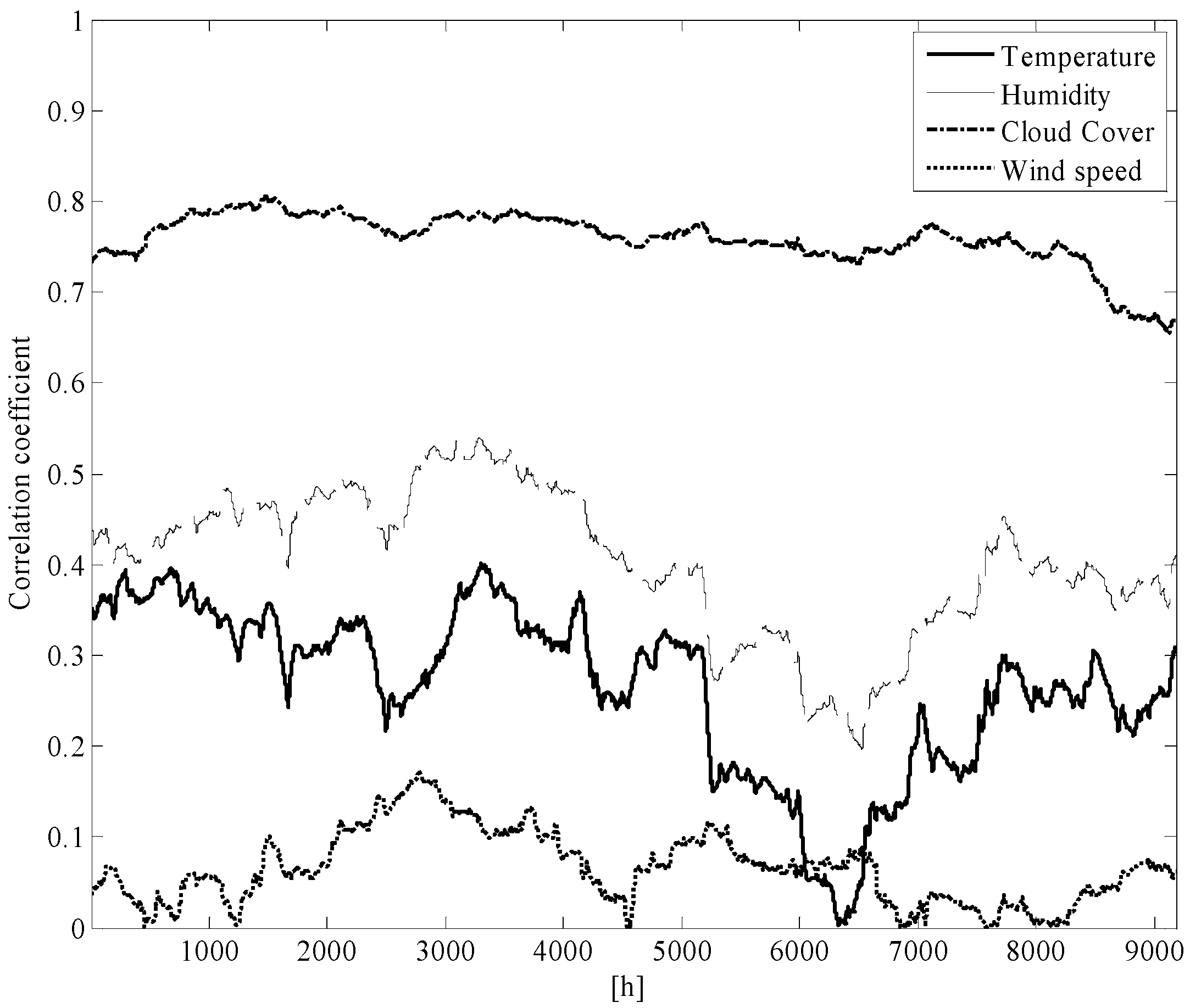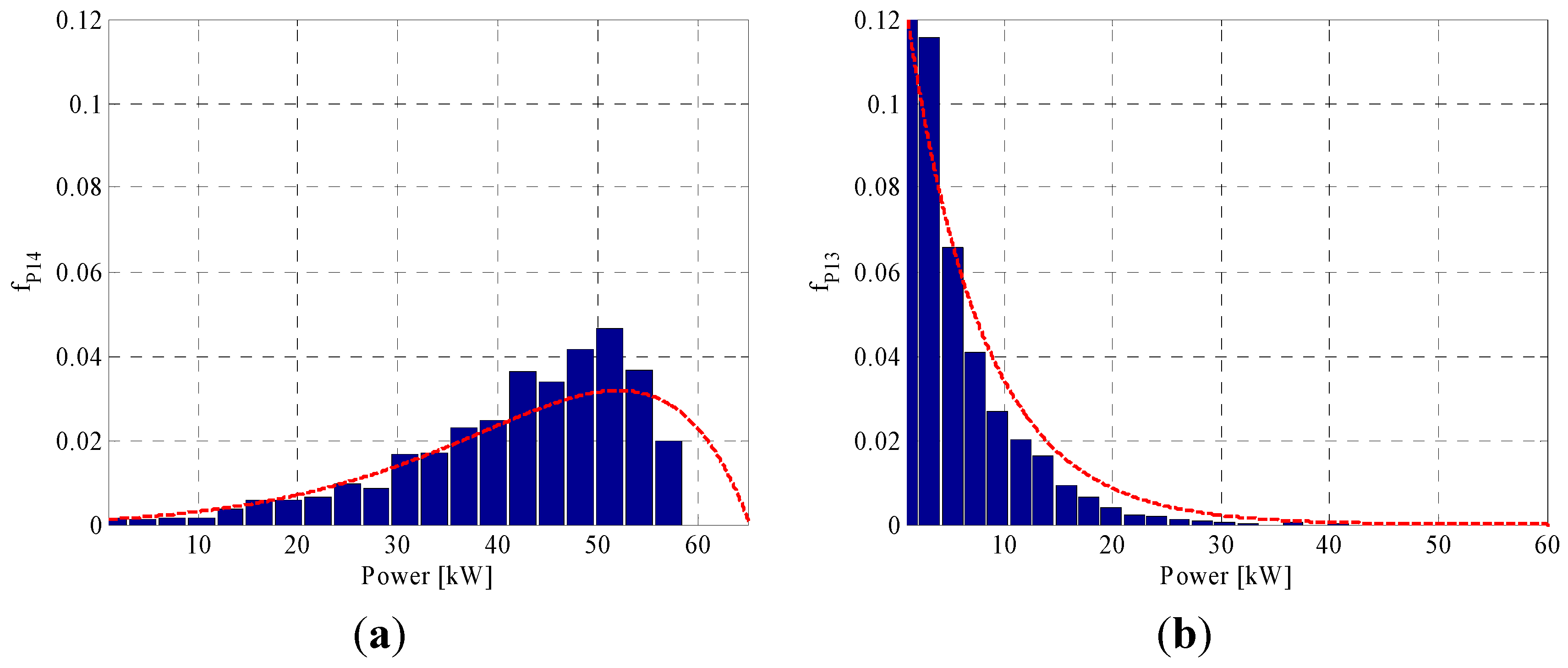A Bayesian Method for Short-Term Probabilistic Forecasting of Photovoltaic Generation in Smart Grid Operation and Control
Abstract
:1. Introduction
2. Probabilistic Forecasting method based on the Bayesian approach
3. Probabilistic Forecasting of the Photovoltaic Generation
- –
- The description of the adopted model for the PV system;
- –
- The description of the pdf modeling the hourly clearness index;
- –
- The definition of the AR time-series model including meteorological variables; and
- –
- The probabilistic characterization of the prior random parameters.
3.1. PV System Model
3.2. Probability Density Function of the Hourly Clearness Index
3.3. AR Time-Series Model
3.4. Probabilistic Characterization of the Prior Random Parameters


4. Experimental Section







5. Conclusions
6. Acknowledgements
References
- Bouhafs, F.; Mackay, M.; Merabti, M. Links to the future: Communication requirements and challenges in the smart grid. IEEE Power Energy Mag. 2012, 10, 24–28. [Google Scholar] [CrossRef]
- Pilo, F.; Pisano, G.; Soma, G.G. Optimal coordination of Energy resources with a two-stage online active management. IEEE Trans. Ind. Electron. 2011, 58, 4526–4537. [Google Scholar] [CrossRef]
- Potter, C.M.; Archambault, A.; Kenneth, W. Building a smarter smart grid to better renewable energy information. In Proceedings of Power Systems Conference and Exposition (PSCE 09), Seattle, WA, USA, 15–18 March 2009.
- Smith, J.C.; Milligan, M.R.; De Meo, E.A.; Parson, B. Utility wind integration and operating impact state of art. IEEE Trans. Power Syst. 2007, 22, 900–907. [Google Scholar] [CrossRef]
- Pinson, P.; Chevallier, C.; Kariniotakis, G.N. Trading wind generation from short-term probabilistic forecasts of wind power. IEEE Trans. Power Syst. 2007, 22, 1148–1156. [Google Scholar] [CrossRef]
- Sharma, N.; Sharma, P.; Irwin, D.; Shenoy, P. Predicting solar generation from weather forecast using machine learning. In Proceedings of IEEE International Conference on Smart Grid Communications (SmartGridComm), Bruxelles, Belgium, 17–20 October 2011; pp. 528–533.
- Watson, R. IEA Expert Meeting on Wind Forecasting Techniques; NREL Report; NREL (National Renewable Energy Laboratory): Golden, CO, USA, 2000. [Google Scholar]
- Liserre, M.; Sauter, T.; Hung, J.Y. Future energy systems: Integrating renewable energy sources into the smart power grid through industrial electronics. IEEE Ind. Electron. Mag. 2010, 4, 18–37. [Google Scholar] [CrossRef]
- Mellit, A.; Massi Pavan, A. A 24-h forecast of solar irradiance using artificial neural network: Application for performance prediction of a grid-connected PV plant at Trieste, Italy. Sol. Energy 2010, 84, 807–821. [Google Scholar]
- Al Riza, D.F; Gilani, S.I.; Aris, M.S. Hourly solar radiation estimation using ambient temperature and relative humidity data. Int. J. Environ. Sci. Dev. 2011, 2, 188–193. [Google Scholar] [CrossRef]
- Yona, A.; Senjyu, T.; Funabashi, T. Application of recurrent neural network to short-term-ahead generating power forecasting for photovoltaic system. In Proceedings of IEEE Power Engineering Society General Meeting, Tampa, FL, USA, 24–28 June 2007.
- Lorenz, E.; Hurka, J.; Heinemann, D.; Beyer, H.G. Irradiance forecasting for the power prediction of grid-connected photovoltaic systems. IEEE J. Sel. Top. Appl. Earth Obs. Remote Sens. 2009, 2, 2–10. [Google Scholar] [CrossRef]
- Li, Y.; He, L.; Nie, R. Short-term forecast of power generation for grid-connected photovoltaic system based on advanced Grey-Markov chain. In Proceedings of IEEE International Conference on Energy and Environment Technology (ICEET ’09), Guilin, China, 16–18 October 2009; Volume 2, pp. 275–278.
- Bacher, P.; Madsen, H.; Nielsen, P. Online short-term solar power forecasting. Sol. Energy 2009, 83, 1772–1783. [Google Scholar] [CrossRef]
- Hassanzadeh, M.; Etezadi-Amoli, M.; Fadali, M.S. Practical approach for sub-hourly and hourly prediction of PV power output. In Proceedings of IEEE Conferences North American Power Symposium, Arlington, TX, USA, 1–5 September 2010.
- Bracale, A.; Caramia, P.; Fantauzzi, M.; Di Fazio, A.R. A Bayesian-based approach for photovoltaic power forecast. In Proceedings of Cigrè International Symposium on Smart Grid, Bologna, Italy, 13–15 September 2011.
- Bracale, A.; Caramia, P.; De Martinis, U.; Di Fazio, A.R. An improved Bayesian-based approach for short term photovoltaic power forecasting in smart grids. In Proceedings of International Conference on Renewable Energies and Power Quality (ICREPQ 2012), Santiago De Compostela, Spain, 28–30 March 2012.
- Bracale, A.; Caramia, P.; Carpinelli, G.; Di Fazio, A.R.; Varilone, P. A Bayesian-based approach for very short-term steady-state analysis of a smart grid. IEEE Trans. Smart Grids 2013, in press. [Google Scholar]
- Gelman, A.; Carlin, J.B.; Stern, H.S.; Rubin, D.B. Bayesian Data Analysis; Chaoman & Hall: London, UK, 1995. [Google Scholar]
- Papoulis, A. Probability, Random Variables and Stochastic Processes; McGraw-Hill: New York, NY, USA, 1991. [Google Scholar]
- Zhang, J.; Pu, J.; McCalley, J.D.; Stern, H.; Gallus, W.A., Jr. A Bayesian approach to short term transmission line thermal overload risk assessment. IEEE Trans. Power Deliv. 2002, 17, 770–778. [Google Scholar] [CrossRef]
- Duffie, J.A.; Beckman, W.A. Solar Engineering of Thermal Processes, 2nd ed.; Wiley Interscience: New York, NY, USA, 1991. [Google Scholar]
- Orgill, J.F; Hollands, K.T.G. Correlation equation for hourly diffuse radiation on a horizontal surface. Sol. Energy 1977, 19, 357–359. [Google Scholar] [CrossRef]
- Kroposki, B.; Emery, K.; Myers, D.; Mrig, L. A comparison of photovoltaic module performance evaluation methodologies for energy ratings. In Proceedings of First World Conference on Photovoltaic Energy Conversion (WPEC 1994), Hawaii, HI, USA, 5–9 December1994; pp. 858–862.
- Ettoumi, F.Y.; Mefti, A.; Adane, A.; Bouroubi, M.Y. Statistical analysis of solar measurements in Algeria using beta distributions. Renew. Energy 2002, 124, 28–33. [Google Scholar]
- Ibanez, M.; Beckman, W.A.; Sanford, A.K. Frequency distributions for hourly and daily clearness indices. J. Sol. Energy Eng. 2002, 26, 47–67. [Google Scholar]
- Liu, B.Y.H.; Jordan, B.C. The interrelationship and characteristic distribution of direct, diffuse and total solar radiation. Sol. Energy 1960, 4, 1–19. [Google Scholar] [CrossRef]
- Bendt, P.; Collares-Pereira, M.; Rabl, A. The frequency distribution of daily insolation values. Sol. Energy 1981, 27, 1–19. [Google Scholar] [CrossRef]
- Hollands, K.T.G.; Huget, R.G. A probability density function for clearness index, with applications. Sol. Energy 1983, 30, 195–209. [Google Scholar] [CrossRef]
- Huang, Y.; Lu, J.; Liu, C.; Xu, X.; Wang, W.; Zhou, X. Comparative study of power forecasting methods for PV stations. In Proceedings of International Conference on Power System Technology (POWERCON 2010), Hangzhou, China, 24–28 October 2010; pp. 1–6.
- Conti, S.; Raiti, S. Probabilistic load flow using Monte Carlo techniques for distribution networks with photovoltaic generators. Sol. Energy 2007, 81, 1473–1481. [Google Scholar] [CrossRef]
© 2013 by the authors; licensee MDPI, Basel, Switzerland. This article is an open access article distributed under the terms and conditions of the Creative Commons Attribution license (http://creativecommons.org/licenses/by/3.0/).
Share and Cite
Bracale, A.; Caramia, P.; Carpinelli, G.; Di Fazio, A.R.; Ferruzzi, G. A Bayesian Method for Short-Term Probabilistic Forecasting of Photovoltaic Generation in Smart Grid Operation and Control. Energies 2013, 6, 733-747. https://doi.org/10.3390/en6020733
Bracale A, Caramia P, Carpinelli G, Di Fazio AR, Ferruzzi G. A Bayesian Method for Short-Term Probabilistic Forecasting of Photovoltaic Generation in Smart Grid Operation and Control. Energies. 2013; 6(2):733-747. https://doi.org/10.3390/en6020733
Chicago/Turabian StyleBracale, Antonio, Pierluigi Caramia, Guido Carpinelli, Anna Rita Di Fazio, and Gabriella Ferruzzi. 2013. "A Bayesian Method for Short-Term Probabilistic Forecasting of Photovoltaic Generation in Smart Grid Operation and Control" Energies 6, no. 2: 733-747. https://doi.org/10.3390/en6020733





